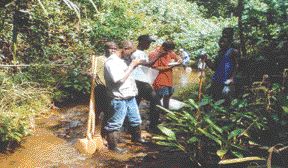Vancouver — The political turmoil that plagued Sierra Leone, Liberia, and Guinea over previous decades has eased considerably in recent years, triggering renewed interest in the diamond potential of the West African nations. Among the companies leading the search is
Mano River holds more than 25,000-sq.-km of ground in the resource-rich African nations where its namesake river winds its way from the Wologizi Mountain Range in northern Liberia to the Atlantic Ocean, where the river acts as a border with Sierra Leone. The company views its holdings as equally prospective for world-class diamond and gold deposits, and operates its exploration programs with both commodities in mind. To date it has uncovered numerous kimberlites and almost 1 million oz. in gold, mostly in classic Archean terranes.
In late May, the company announced the discovery of a new kimberlite at its MCA licence in western Liberia, just four months after launching an exploration program in the region.
The MCA project is a joint venture held 30% by the government of Liberia and 70% by the company. In addition to diamonds, the properties are prospective for gold and base metals.
The recent discovery was made following a soil-sampling program that revealed abundant ilmenite and garnet in a specific area of interest. Shallow pits dug over the sample sites intersected highly decomposed kimberlite at a depth of about 1 metre.
The company has expanded the soil-sampling program to search for new kimberlites using local geomorphology and the presence of artisanal diamond workings as a guide. Based on these factors and recent sampling results, the company believes that other kimberlites may be present near its existing discovery. Ground gravity and magnetic geophysical surveys are also planned to guide ongoing exploration.
Elsewhere in Liberia, Mano River has launched detailed ground geophysical surveys over a diamondiferous kimberlite cluster at Weasua. This project is a joint venture with South Africa’s
In western Liberia, Mano River is involved in a joint venture with African Aura Resources. This deal supplements the company’s existing holdings in the region. The newly acquired ground includes the Israel area, an active diamond-mining region for more than 50 years, where an estimated 40,000 artisans were active at one time.
In neighbouring Sierra Leone, the company is carrying out a regional program at a 9,700-sq.-km exploration licence in a partnership with
The land package is viewed as prospective for diamonds, gold and base metals, however recent exploration and the presence of artisanal diamond workings have revealed good potential for diamond-bearing kimberlites.
The favourable geology and indicator minerals obtained from recent samples have prompted the partners to launch a second-phase program to include additional sampling, ground geophysics, pitting and drilling.
BHP Billiton can earn a 51% interest in the licences by funding two phases of exploration valued at US$3.4 million over three years. It can boost its interest to 70% by completing a feasibility study over one or more kimberlites believed to have economic potential.
In the rural Kono area of Sierra Leone, Mano River and Aussie partner
In the Kerouane district of southeastern Guinea, Mano River is exploring three newly acquired exploration licences previously held by
As part of the deal, De Beers agreed to provide Mano River its exploration and modelling data in return for a small cash payment and a 2% gross royalty on future diamond sales. Mano retains all marketing rights to the diamonds.
After reviewing the De Beers data, Mano River reports that the licences host four extensive, diamond-bearing kimberlite dyke complexes. One such dyke, Bouro North, has been mapped and drilled discontinuously over a strike length of 5 km.
De Beers collected 11 samples totalling 1,920 kg from Bouro North and recovered 4,635 diamonds totalling 10.44 carats. This includes a sizable portion of “commercial-sized” diamonds in the 1- to 2-millimetre size fractions. The property covers numerous kimberlite indicator mineral anomalies that have yet to be tested.
On the gold front, Mano River plans to focus its efforts in Liberia, which together with a large part of Sierra Leone and southeastern Guinea, is underlain by a classic Archean greenstone belt. The company says the under-explored belt has similarities to the Lake Victoria Goldfields of Tanzania, where more than 40 million oz. of gold have been found to date by various companies.
The most advanced gold projects so far are the KGL and Weaju deposits in Liberia, which together host a resource containing roughly 840,000 oz. gold, which could be mined by open-pit methods. A preliminary resource of about 100,000 oz. has been defined at the Missamana and Gueliban prospects in Guinea. In Sierra Leone, the company has secured ground in the Sula Mountains greenstone belt, considered the highest potential gold structure in the nation.
Assuming all third-party commitments are realized, Mano River estimates that more than US$16 million could be spent to explore and develop its West African gold and diamond properties this year.
The company also used its existing infrastructure in Liberia, Sierra Leone and Guinea to administer social programs aimed at improving the lives of local citizens.
One important focus of the Mano Foundation is the promotion of domestic rice production, particularly in Liberia, where it is the main food staple. Others are the establishment of clinics to combat disease and the building of roads and bridges to improve access.


Be the first to comment on "Mano River hunts West African diamonds"